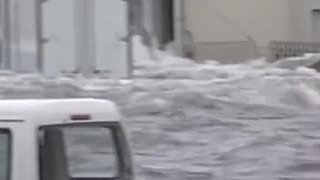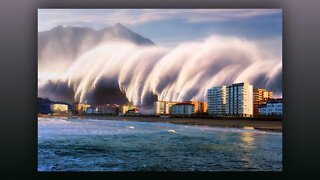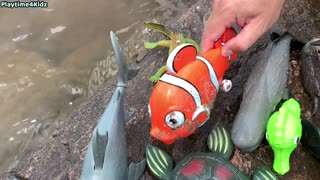The Dangerous Tsunami
Introduction
A tsunami is a series of large waves generated by the displacement of a large volume of water in an ocean or a lake. Earthquakes, volcanic eruptions and other underwater disturbances can cause tsunamis.
The word "tsunami" comes from the Japanese words "tsu", meaning "harbour" and "nami", meaning "wave". Tsunamis are also sometimes called "tidal waves", but this is a misnomer, as they have nothing to do with tides.
Causes of Tsunamis
The most common cause of tsunamis is earthquakes. When an earthquake occurs underwater, it can displace a large volume of water, creating a wave. The size of the wave depends on the magnitude of the earthquake and the depth of the water.
Volcanic eruptions can also cause tsunamis. When a volcano erupts underwater, the force of the eruption can displace a large volume of water, creating a wave.
Other underwater disturbances that can cause tsunamis include landslides, asteroid impacts and submarine explosions.
How Tsunamis Work
When a tsunami is generated, it travels outward in all directions from the point of origin. The waves can travel at speeds of up to 800 kilometers per hour (500 miles per hour) in the open ocean.
As the waves approach land, they slow down and become taller. The tallest tsunami waves can be over 100 meters (330 feet) high.
Effects of Tsunamis
Tsunamis can cause widespread destruction. The waves can sweep away buildings, roads, bridges and other infrastructure. They can also cause flooding, which can contaminate drinking water and spread disease.
Tsunamis are also a major cause of death. The most common cause of death is drowning, but people can also be killed by being struck by debris, falling from buildings or being electrocuted.
Tsunami Warning Systems
There are tsunami warning systems in place in many parts of the world. These systems use sensors to detect earthquakes and other underwater disturbances that could generate tsunamis. If a tsunami is detected, the warning system will send an alert to people in the affected area.
Tsunami Preparedness
There are a number of things that people can do to prepare for a tsunami. These include:
Learning about the tsunami risks in your area.
Developing an evacuation plan.
Having a disaster kit that includes food, water, first aid supplies and other essential items.
Staying informed about tsunami warnings.
Conclusion
Tsunamis are a powerful and destructive force of nature. However, by being prepared, people can reduce the risk of death and injury from a tsunami.
Additional Information
The most destructive tsunami in recorded history occurred in 2004, when an earthquake off the coast of Indonesia triggered a series of tsunamis that killed over 230,000 people in 14 countries.
The United States has experienced several major tsunamis, including the 1946 Aleutian Islands tsunami, which killed over 165 people, and the 1964 Alaska earthquake, which triggered a tsunami that killed over 120 people.
There are a number of things that can be done to reduce the risk of tsunamis, such as building seawalls and levees, and improving early warning systems.
I hope this essay has provided you with a better understanding of tsunamis. If you have any further questions, please do not hesitate to ask.
-
 5:45
5:45
shyamdev
9 months agoThe Most Dangerous Waves Of The World
6 -
 6:56
6:56
StormWarningNews
1 year agoThe Coming Tsunami Wave Of Fear
4 -
 2:23:38
2:23:38
BoilingPoint.Live
5 months agoIn Dangerous Waters
2722 -
 3:25
3:25
Waking the World up
6 months agoThe Power and Danger of a Tsunami – Japan 2011
6901 -
 0:39
0:39
EveryThingWildd
5 months agoHow Dangerous Is a The Coastal Taipan!
241 -
 9:42
9:42
StillSmallVoice
1 year agoMega Tsunami and The Warning
1882 -
 9:37
9:37
Church Militant
1 year agoCatholic — News Report — Lethal Tsunami
2844 -
 3:25
3:25
1 W1LL B3 Y0UR
2 years agoDangerous Sea Creatures!!!!
33 -
 2:05
2:05
Gravity123
1 year agoTSUNAMI
48 -
 7:33
7:33
He is the King of Kings
8 months agoDream Of Tsunami!! EAST COAST BEWARE!!!!
1